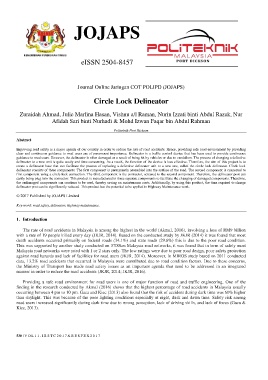Page 531 - eProceeding-IRSTC2017 & RESPEX2017
P. 531
JOJAPS
eISSN 2504-8457
Journal Online Jaringan COT POLIPD (JOJAPS)
Circle Lock Delineator
Zuraidah Ahmad, Julie Marlina Hasan, Vishnu a/l Raman, Nurin Izzati binti Abdul Razak, Nur
Afidah Sari binti Nurhadi & Mohd Izwan Faqar bin Abdul Rahman
Politeknik Port Dickson
Abstract
Improving road safety is a major agenda of our country in order to reduce the rate of road accidents. Hence, providing safe road environment by providing
clear and continuous guidance to road users are of paramount importance. Delineator is a traffic control device that has been used to provide continuous
guidance to road users. However, the delineator is often damaged as a result of being hit by vehicles or due to vandalism. The process of changing a defective
delineator to a new unit is quite costly and time consuming. As a result, the function of the device is less effective. Therefore, the aim of this project is to
create a delineator base that can facilitate the process of replacing a defective delineator unit to a new one, called the circle lock delineator. Circle lock
delineator consists of three components. The first component is permanently assembled into the surface of the road. The second component is connected to
first component using a circle lock connection. The third component is the connector, screwed to the second component. Therefore, the delineator post can
easily being plug into the connector. This product is manufactured in three separate components to facilitate the changing of damaged components. Therefore,
the undamaged components can continue to be used, thereby saving on maintenance costs. Additionally, by using this product, the time required to change
delineator post can be significantly reduced. This product has the potential to be applied in Highway Maintenance work.
© 2017 Published by JOJAPS Limited
Key-word: road safety, delineator, highway maintenance.
1. Introduction
The rate of road accidents in Malaysia is among the highest in the world (Akmal, 2016), involving a loss of RM9 billion
with a rate of 19 people killed every day (JKJR, 2014). Based on the conducted study by JKJR (2014) it was found that most
death accidents occurred primarily on federal roads (34.1%) and state roads (29.6%) this is due to the poor road condition.
This was supported by another study conducted on 3700km Malaysia road networks, it was found that in term of safety most
Malaysia road networks were rated with 1 or 2 stars only. The low ratings were due to poor road design, poor safety protection
against road hazards and lack of facilities for road users (JKJR, 2014). Moreover, in MIROS study based on 2011 conducted
data, 13.2% road accidents that occurred in Malaysia were contributed due to road condition factors. Due to these concerns,
the Ministry of Transport has made road safety issues as an important agenda that need to be addressed in an integrated
manner in order to reduce the road accidents (JKJR, 2014; JKJR, 2016).
Providing a safe road environment for road users is one of major function of road and traffic engineering. One of the
finding in the research conducted by Akmal (2016) shows that the highest percentage of road accidents in Malaysia usually
occurring between 4 pm to 10 pm. Gaca and Kiec (2013) also found that the risk of accident during dark time was 60% higher
than daylight. This was because of the poor lighting conditions especially at night, dusk and dawn time. Safety risk among
road users increased significantly during dark time due to wrong perception, lack of driving skills, and lack of focus (Gaca &
Kiec, 2013).
530 | V O L 1 1 - I R S T C 2 0 1 7 & R E S P E X 2 0 1 7

